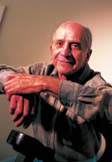
Few of us will reach our octogenarian years with as much vigor as Guido Brassesco. Each day the 81-year-old Stockton resident rides a stationary bike for half an hour and spends another half-hour on push-ups and sit-ups. Then he goes to service club meetings, classes, or to visit friends. Sure, his ankles are a little gimpy from some shrapnel he caught in World War II, and he's got a touch of high blood pressure, but all in all, life is good. Well, except for that kidney cancer scare a few years back. But thanks to early detection and a sophisticated surgery that Brassesco underwent at the UC Davis Medical Center, his only reminder of that experience is a small, two-inch scar near his abdomen. Brassesco sought help a year ago shortly after he began passing blood in his urine. His physician thought he had an infection, but subsequent tests revealed a large mass on his right kidney. "It scared the heck out of me," Brassesco recalls. "I couldn't believe I had cancer, because I felt fine. How could I be sick?" Kidney cancer strikes more than 30,000 people in the United States each year, killing more than 10,000. Once disease spreads, it is hard to treat. But when it's caught early, a surgery to remove the diseased kidney and adjacent adrenal gland and fat - a procedure called a radical nephrectomy - is effective without the need for chemotherapy or radiation.
Home |
Table of Contents |
To our Readers |
Building on Basics UC Davis Health System | © 2000, 2001, 2002 UC Regents. All rights reserved. |
Laparoscopic nephrectomy is another way minimally invasive surgery helps cancer patients |

